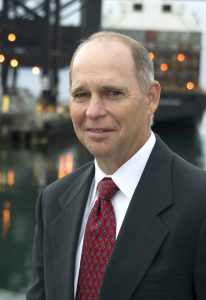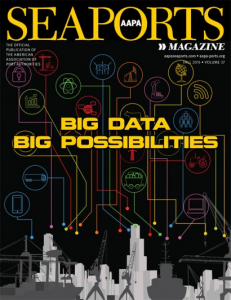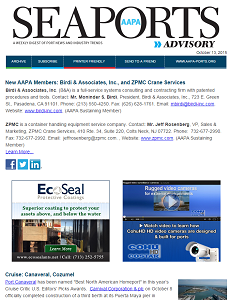Kurt Nagle: Fostering Global Collaboration

We caught up with Kurt Nagle, president and CEO of the American Association of Port Authorities, just as Hurricane Joaquin barreled up the East Coast earlier this month. Find out what makes this 103-year-old global trade association such a heavyweight when it comes to advocacy, economic impact and public policy.
![]()
We’ve always had a strong culture of collaboration and information sharing internally, nationally and globally.
Over one-fourth of the U.S. economy and 23 million jobs are tied to what’s moving through our ports.
Non-dues revenue is a balancing act. You always want to look for opportunities, but also respect members and protect your brand.
Association Adviser: How many members does AAPA have and how do you categorize them?
Kurt Nagle: We represent about 140 public port authorities throughout the hemisphere — 80 in the U.S., with the remainder in Canada, the Caribbean and Latin America. We also have more than 250 sustaining members — firms and organizations that provide engineering services, security and technology to maritime industries. These are organizational memberships. That means everyone working at a member company or port authority has access to AAPA and its services. So, we have about 2,500 people reading our member magazine, Seaports Magazine.

AA: Kurt, tell us about your career track. Do you have a maritime background?
KN: Actually, no. I just celebrated my 30th year at AAPA and my 20th year as CEO. Before AAPA, I spent seven years at the National Coal Association focusing on international trade and coal exports. That allowed me to utilize my master’s in economics. Back then, the Coal Association had a regular data exchange with AAPA regarding coal exports. That’s how I developed my relationship with AAPA and got to know them.
AA: What do you find so appealing about association work?
KN: It’s the culture of collaboration within AAPA and throughout the port industry. It’s that common bond we share, that ability to facilitate the exchange of information, knowledge and experience within our industry. It’s the collective ability to address and resolve common issues and challenges, from hurricanes, security and the environment, to meeting our infrastructure needs. That’s one of the things I find very rewarding.
AA: With Hurricane Joaquin soaking the Eastern seaboard as we speak, will seaports be getting extra media attention?
KN: Since Hurricane Katrina, we’ve learned many lessons about emergency preparedness and what individual ports are supposed to do 72, 48 and 24 hours in advance of a major storm. We had emergency plans before Katrina, but as an industry, we’re now much better prepared. That’s the culture of our industry — that willingness to share lessons learned from the past and best practices going forward. It was the same way after 9/11. Before that tragedy, port security was mostly about preventing break-ins and cargo theft. Now, the focus is on anti-terrorism and protecting the facilities, cargo and vessels in our ports, and keeping [unwanted] vessels and dangerous cargo out.
AA: Your organization is called the American Association of Port Authorities, but you clearly have a global focus.
KN: That’s right. Let me clarify that “American” refers to all of the Americas, including Canada, Central America and South America. Our focus is on building relationships and partnerships throughout the hemisphere, and we have agreements with the European Port Association and the International Association of Ports and Harbors to collaborate on broader issues that affect us all.
AA: Speaking of outreach, tell us more about “Seaports Deliver Prosperity.”
KN: The Seaports Deliver Prosperity initiative is all about making policy makers and influencers throughout our hemisphere aware of the critical role that seaports play in terms of our well-being —from jobs and economic vitality to global competitiveness. Did you know that over one-fourth of the U.S. economy and 23 million jobs are tied to what’s moving through our ports? That’s why it’s so important to keep investing in our seaport infrastructure to keep us globally competitive.
AA: What are your members’ biggest challenges and how are you addressing them?
KN: The U.S. used to be the 800-pound gorilla of world trade, even though we account for only 5 percent of the world population and 20 percent of consumption. The perception was that the rest of the world needed to come to us and would always be anxious to trade with us. That’s no longer the case. We need to be more competitive as many other countries are investing in their waterborne maritime infrastructure which includes their seaports. At least 95 percent of all international trade moves by water. All of that global trade and growth can pass us by and is passing us by if we don’t remain competitive. Our shipping channels need to be deepened and widened to accommodate larger vessels. And then there’s the ‘first mile/last mile’ connection: getting the goods from the manufacturer to the ports so we can export competitively.
AA: Is that where advocacy comes into play?
KN: A lot of our advocacy work in D.C is focused on the need to invest in our infrastructure in and around ports. Again, 25 percent of the U.S. economy moves through ports, and we need to increase their efficiency or else jobs and economic growth could be jeopardized. As I mentioned earlier, it’s all about bringing the industry together on common challenges and working collectively with policy makers to address them. For instance, how can we increase the efficiency of our existing [seaport] infrastructure and get more out of it. It all comes down to increasing awareness of the value of our ports and the need to invest in them.
AA: Let’s talk about your member communications vehicles and how you get the word out.
KN: In addition to Seaports Magazine (2,500 readers) and the AAPA Industry Services Directory, we have the Alert Newsletter, which provides frequent updates about legislative and regulatory issues affecting U.S. ports, and the weekly Seaports Advisory, which provides a weekly digest of news and trends affecting ports.

AA: What’s changed the most about your member communications in recent years?
KN: We continue to increase our social media presence. That’s expanded our reach with members as well as with folks on Capitol Hill and the general public. Social media makes it easier for our members to share our message with their constituents and communities. Twitter has probably had the greatest application for getting messages out to the public and to Capitol Hill people who are always on their iPhones. We’re also revitalizing our website so it will have responsive capabilities. We recognize the need to make it easier for members and policy makers to access and digest all of our materials on a device like an iPhone.
See Hank Berkowitz’s story for more about association communication trends over the past four years.
AA: How about non-dues revenue? Your communication channels seem to be successful at attracting advertising and sponsors.
KN: As with many associations, there has been an increase in NDR here as we try to keep dues down. With Naylor’s help, we have advertising in all of our media, including our website and newsletters. We also have sponsors for our seminars, conferences and annual convention. We want sponsorships that not only bring in revenue, but make the maritime industry aware of useful products and services.
AA: That’s great, but can non-dues revenue go too far?
KN: Historically, we’ve been on the conservative side of the NDR question. We try to be respectful of our members. We try not to take away from the overall appearance or substance of our website, newsletters and magazine. We’re judicious about where ads are placed, and we don’t allow pop-ups or other types of intrusive ads or advertorials. Clearly, it’s a balancing act. You always want to look for opportunities, but at the same time protect your image and the brand of the association and the industry.
AA: How would you describe your leadership style?
KN: My style is not to micromanage. It’s about setting clear goals and priorities for the organization, making sure everyone understands them, and then let them run with it. I have more opportunities than most staff to get out and talk to members and take the pulse of the industry. It’s my job to bring that [information] back to my team and help them understand how to use it within their own departments.
AA: Speaking of younger staff, do you have any special strategies for working with millennials?
KN: Over the years, older generations have always had to figure out how to work with younger colleagues. It didn’t start with the millennials. We have a good mix of staff ranging from those in their 20s to those in their 60s. You need that balance. I’m 60 now. My generation is very different from Generation X, and millennials are clearly different from the older generations. They’re very driven and enthusiastic. They want to be innovative and creative. As long as you provide them with good guidance about the organization’s goals, then you’re going to get good ideas and creative [solutions] from them.
AA: Let’s go back to innovation for a minute. Do you have a formal process for developing new ideas?
KN: It’s a mix of informal and strategic. We only have 17 employees. We don’t need separate task forces or processes to explore a new initiative. It’s a collaborative, interactive process. Almost everyone here got involved in the website redesign — everyone from government relations, communications and research folks, to the Web team and me. On a more formal basis, we conduct an annual Relevance Survey and then break down [the results] by member sub-groups such as Latin American port, European port, container ports, bulk port or small port. We use the survey results to provide space and forums for each group to collaborate with each other about issues they have in common.
AA: Any final thoughts for our readers and followers?
KN: It’s important for an association to stay aligned with its members at all times. Our 103-year history means nothing if we’re no longer relevant to members today and no longer provide them with the value and benefits that they need going forward.

